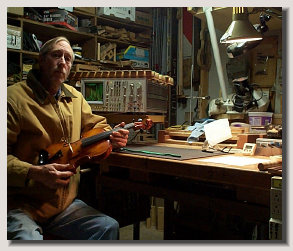Page 1 of 2
Acoustical Tuning Information Page
for stringed instruments (violin, viola, Cello, Bass...)
( Copyright 2018 (c) by David Langsather)
David Langsather violin maker/ researcher
3425 Fairhaven Avenue N.E.
Salem, Oregon 97303 USA
(503) 364- 8685 PST
'e' mail me your comments and questions at: info@violinresearch.com

I have named the process I am describing here, 'Acoustical Tuning'. This technique expands the concept of Tap Tone Tuning to include all parts of the instrument, so that each part works in harmony with the rest.
This information is the result of nineteen years of research to determine what makes violin family intstruments produce superior sound. After sorting through many ideas and techniques offered by others, and with the help of Ron Kilde as my professional violinist giving playing feed back, and doing many tests and trials of my own ideas, this technique of 'Acoustical Tuning' has evolved and been refined until now.
In a 'nut shell', any vibrating string interacts with its support structure (the instrument) and the effect of the support structure (the instrument) either enhances or detracts from sound quality of the vibrating string.
What I believe I have determined is how this interaction operates, how it is measured and how it is adjusted for each part, for the benefit of the instrument.
Based on my extensive testing program, I think I have identified the major key elements for a successful instrument. Importantly, most well made instruments can be adjusted to these ideal circumstances within a few hours by a professional in this field through this process of 'acoustical tuning'.
..Wood Selection is another important subject: please see new areas on Wood Tone and Rub Tone for selection ideal instrument making woods. (2017)
The benefits of 'acoustical tuning' include:
- First: loudness is incresased, often from 10 to 30%.
- Second: tone quality seems to improve in the same or greater percentage as loudness.
- Third: Almost perfect evenness results throughout the entire fingerboard, and response if improved.
As you will see on the next pages, this process involves three stages and takes me several days to accomplish. All changes on external to the instrument, and the amount of material removed is slight. The cost is economical and the imporvements permanent'.
*The first stage involves determining the current frequencies of the instrument by measuring 'tap tones' with a labratory acoustical spectrum analyzer. ( I use a Hewlett Packard 3582A Spectrum Ananyzer) These are recorded and a copy is given to you.
- The second stage is to make the adjustments by scraping or sanding various areas of the fingerboard, tailpiece, nut, and end pin; all the time moving toward the acoustical goals set for the particular instrument after a review of the results obtained in stage one above.
(see next page for more details..)
* The third stage is restringing the instrument and test playing, noting minor tuning problems which are then also adjusted until at last the instrument is at its optimun adjustment.


Please go to next page for continuation of 'acoustical- tuning'
(click the 'next page arrow at below...)
(modified 3/2018)
Page AT_01






